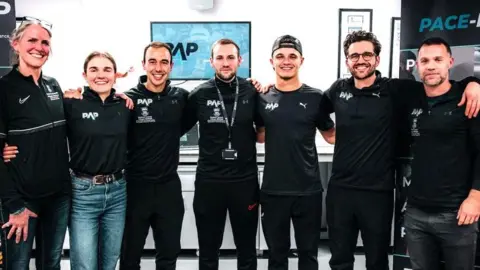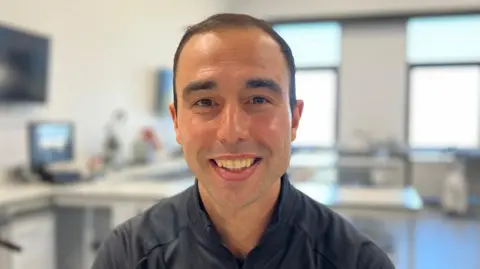The Welsh uni helping F1's Lando Norris triumph
Driving at speeds of more than 200mph, punishing G-force, soaring temperatures and adjusting to new time zones.
Just a few things a Formula One driver faces during the season.
Wales may have been the first nation in the UK to adopt 20mph as the default speed limit on some roads – but sports scientists here are also helping F1 driver Lando Norris hit top speeds.
The team at Swansea University put the McLaren driver through rigorous testing ahead of the season to help inform his training and push him to the top of the podium.
"Look at an F1 driver, there's 24 races plus testing across a year," explained Jon Malvern, who is Norris's performance coach.
"You have international travel, different time zones, hostile hot environments with massive humidity pressure.
"How do you consistently help them turn up with the capacity to do that three or four days a week, 24 weeks of the year?"
 Jon Malvern
Jon MalvernLast weekend's race in Japan, to this weekend's in Bahrain is a six hour time difference to adapt to.
Singapore's grand prix later this year is known for its extreme heat and humidity, with temperatures reaching up to 34C (93F) coupled with up to 90% humidity.
Racers' thick protective suits mean temperatures in the cockpit can soar as high as 60C (140F) with some racers losing several kilograms of sweat during the race.
It's racers' "ability to thermoregulate" that Swansea University's "environmental chamber" tests, among other factors a racer will face on and off the track.
 Swansea University
Swansea UniversityThe 2025 season favourite, Bristol-born Norris, documented the day of rigorous testing in the Welsh labs for his YouTube channel, which also involved assessing "neck strength and neck profiling" to prepare for G-force during braking and steering, and checking grip strength and reaction times.
Lando's coach of 12 years then has the responsibility of turning that data into a competitive edge.
Jon travels the world with the McLaren star, who is currently top of the championship leader board, all with the hope of helping him perform at his best.

"The big golden rule is - anything that can negatively affect lap time, we want to be able to assess it, grade it and, if it needs it, improve it. We help them build that physical and mental capacity," said Jon.
He established the official partnership between his company, Pioneered Athlete Performance and Swansea University's Physiological, Athletic and Cognitive Enhancement for Motorsport Athlete Performance (PACE-MAP) project.
After looking at many different universities that "didn't quite tick all the boxes" or "didn't feel quite right", Jon was drawn to Swansea's "amazing facilities" and "excellent academics and research".

"It was certainly a huge privilege to work with someone of his [Norris's] level and calibre", he said.
"Swansea University is one of the first institutions globally to conduct human research across the elite categories of formula motorsport."
With the difference between first and second often coming down to a matter of milliseconds, every detail matters.
"Historically, there has been a stereotype that drivers are not athletes," said Christian Vassalo, who is involved in the project and is a sports science lecturer.
"But that perception is changing. It's very clear, physiologically, biomechanically, these drivers are very impressive at what they do.
"This data allows the driver to leave no stone unturned when it comes to the preparation."
The research centre's lead, Prof Liam Kilduff said the impact had been "wide reaching".
"What you find with a lot of these sort of things, is it drips through to student applications," he said.
This weekend, Norris will be hoping for a win in Bahrain to stay top of the drivers' standings and there'll be a small team in Swansea cheering him on.
